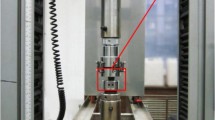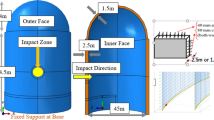Abstract
In order to assess various design concepts and choose a kind of covering cap design scheme which can meet the requirements of airworthiness standard and ensure the safety of fuel tank. Using finite element software ANSYS/LS- DYNA, the impact process of covering cap of aircraft fuel tank by projectile were simulated, in which dynamical characteristics of simple single covering cap and gland double-layer covering cap impacted by titanium alloy projectile and rubber projectile were studied, as well as factor effects on simple single covering cap and gland double-layer covering cap under impact region, impact angle and impact energy were also studied. Though the comparison of critical damage velocity and element deleted number of the covering caps, it shows that the external covering cap has a good protection effect on internal covering cap. The regions close to boundary are vulnerable to appear impact damage with titanium alloy projectile while the regions close to center is vulnerable to occur damage with rubber projectile. Equivalent strain in covering cap is very little when impact angle is less than 15°. Element deleted number in covering cap reaches the maximum when impact angle is between 60°and 65°by titanium alloy projectile. While the bigger the impact angle and the more serious damage of the covering cap will be when rubber projectile impact composite covering cap. The energy needed for occurring damage on external covering cap and internal covering cap is less than and higher than that when single covering cap occur damage, respectively. The energy needed for complete breakdown of double-layer covering cap is much higher than that of single covering cap.

















Similar content being viewed by others
References
Zhang, J.K., Zhang, X.: An efficient approach for predicting low-velocity impact force and damage in composite laminates. Compos. Struct. 130, 85–94 (2015)
Wang, F.S., Yue, Z.F.: Numerical simulation of damage and failure in aircraft windshield structure against bird strike. Mater. Des. 31(2), 687–695 (2010)
Gong, M.W., Yiannis, A.: Coupled fluid–structure solver: the case of shock wave impact on monolithic and composite material plates. J. Comput. Phys. 12(228), 4400–4434 (2009)
Shintate, K., Sekine, H.: Numerical simulation of hypervelocity impacts of a projectile on laminated composite plate targets by means of improved SPH method. Compos. Part A 6(35), 683–692 (2004)
Erkan, K., Dieter, P., Alexander, K., Nils, G., Josef, M.: Simulating the impact behaviour of composite aircraft structures. 2003 ABAQUS user’s conference, Munich, Germany, pp. 1–9 (2003)
Peter, J.D., Luke, A.S., Norman, T.: The hydrodynamic ram pressure generated by spherical projectile. Int. J. Impact Eng. 6(36), 821–829 (2009)
Peter, J.D., Luke, A.S., Norman, T.: Mitigation of shock waves within a liquid filled tank. Int. J. Impact Eng. 2–3(38), 61–72 (2011)
Mines, R.A.W.: A one-dimensional stress wave analysis of a lightweight composite armour. Compos. Struct. 64(1), 55–62 (2004)
Mines, R.A.W., McKown, S., Birch, R.S.: Impact of aircraft rubber tyre fragments on aluminium alloy plates: I-Experimental. Int. J. Impact Eng. 4(34), 627–646 (2007)
Karagiozova, D., Mines, R.A.W.: Impact of aircraft rubber tyre fragments on aluminium alloy plates:II—Numerical simulation using LS-DYNA. Int. J. Impact Eng. 4(34), 647–667 (2007)
Johnson, A.F., Kempe, G., Simon, J.: Design of composite wing access covering under impact loads. Appl. Compos. Mater. 4(7), 219–229 (2000)
Li, Y.Z., Chen, G.: Numerical simulation of liquid-filled tank response to projectile impact. J. Mech. Strength 1(29), 143–147 (2007) (in Chinese)
Liu, X., Zhang, X.Q.: Study on damage of fiber reinforced composite laminate under low velocity impact base on LS-DYNA. Sci. Technol. Eng. 12(12), 2888–2892 (2012)
Livermore Software Technology Corporation. LS-DYNA Keyword User’s Manual, Volume II: Material Models, Version 971. Livermore, California USA (2013)
Livermore Software Technology Corporation. LS-DYNA Theory Manual, Material Models. Livermore, California USA (2006)
Albrecht, A.B., Ravi-Chandar, K.: High strain rate response of rubber membranes. J. Mech. Phys. Solids 64, 377–395 (2013)
Acknowledgments
This study is supported by the National Natural Science Foundation (No: 51475369).
Author information
Authors and Affiliations
Corresponding author
Rights and permissions
About this article
Cite this article
Wang, F., Jia, S., Wang, Y. et al. Impact Response Study on Covering Cap of Aircraft Big-Size Integral Fuel Tank. Appl Compos Mater 23, 953–972 (2016). https://doi.org/10.1007/s10443-016-9496-1
Received:
Accepted:
Published:
Issue Date:
DOI: https://doi.org/10.1007/s10443-016-9496-1




